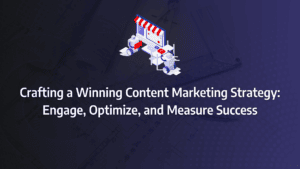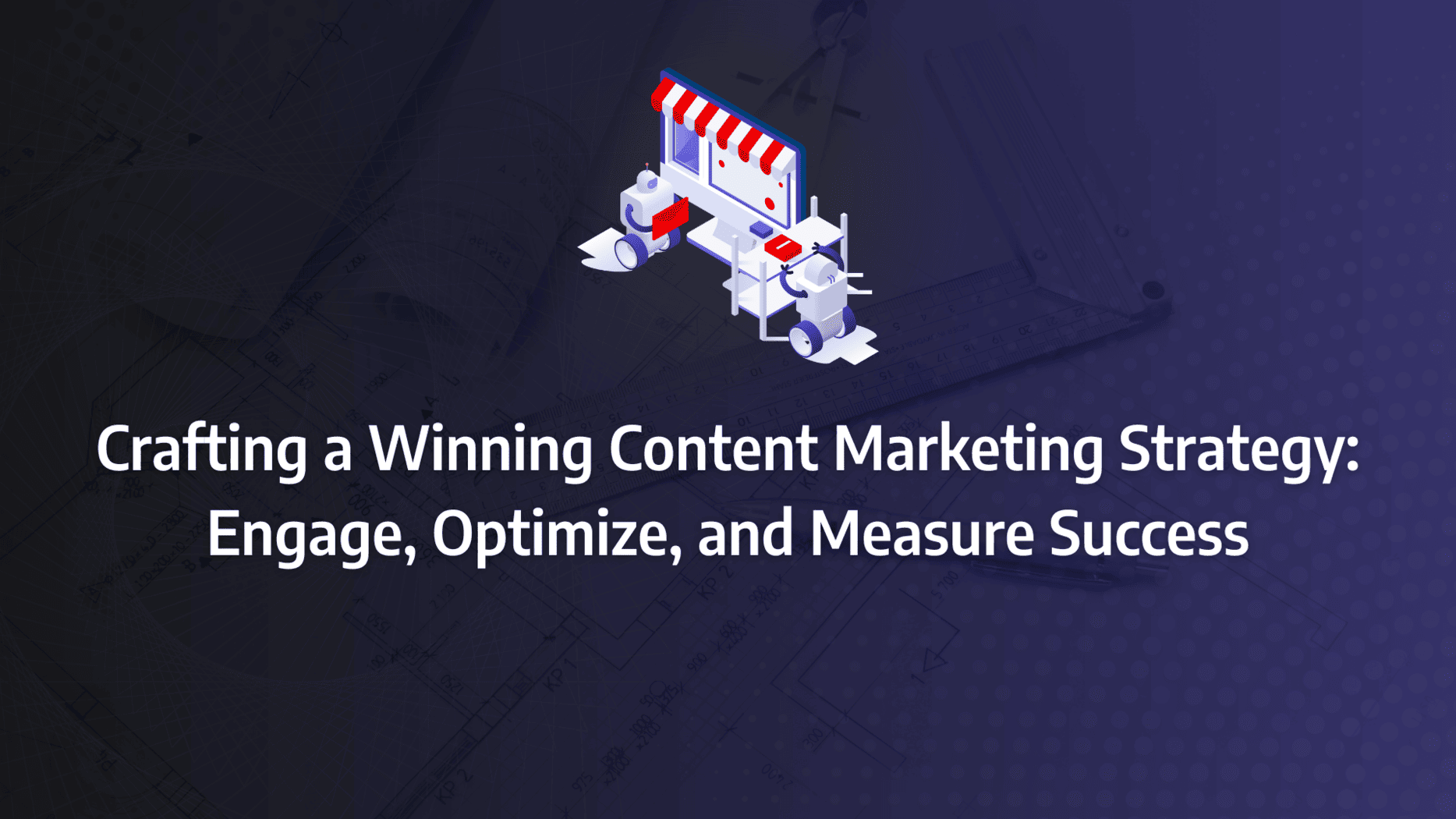Content marketing has become the cornerstone of any successful business strategy. But crafting a content marketing plan that truly resonates with your audience and drives measurable results can feel like a daunting challenge. Perhaps you’ve found yourself overwhelmed by the sheer volume of content required, or frustrated by strategies that don’t seem to yield the expected return. You’re not alone.
This guide will break down the process into manageable steps, offering practical insights and strategic advice that will help you not only create but also execute a content marketing plan that aligns with your business goals and maximises your ROI. You’ll have the tools and knowledge to turn your content marketing efforts into a powerhouse of engagement and growth.
- Start with Clear Objectives: Define specific, measurable goals for your content marketing plan that align with your overall business objectives.
- Know Your Audience: Conduct thorough research to understand your target audience’s needs, preferences, and pain points, ensuring your content is relevant and valuable.
- Content Planning and Organisation: Develop a content calendar that outlines your publishing schedule, types of content, and distribution channels to maintain consistency and focus.
- Create High-Quality Content: Focus on producing content that is not only engaging but also provides real value to your audience, positioning your brand as a thought leader.
- Distribution and Promotion: Ensure your content reaches the right audience by using a mix of owned, earned, and paid media channels effectively.
- Analyse and Optimise: Regularly review your content performance metrics to identify what’s working and where improvements can be made, allowing you to refine your strategy continuously.
What issues indicate I need a comprehensive content marketing strategy?
Crafting a robust content marketing strategy is essential for marketers aiming to achieve sustained success. Without a strategic content marketing plan, efforts are often executed haphazardly, leading to inefficiencies and missed opportunities. If you’ve encountered any of the following scenarios, it’s time to establish a comprehensive content marketing strategy:
- You’ve exhausted your ideas and run out of things to post.
- You manage multiple channels but are unsure which type of content works best on each.
- You lack insight into what topics your audience truly engages with.
- You suddenly realise you haven’t posted any content for the day.
- You are frequently at a loss about what to post.
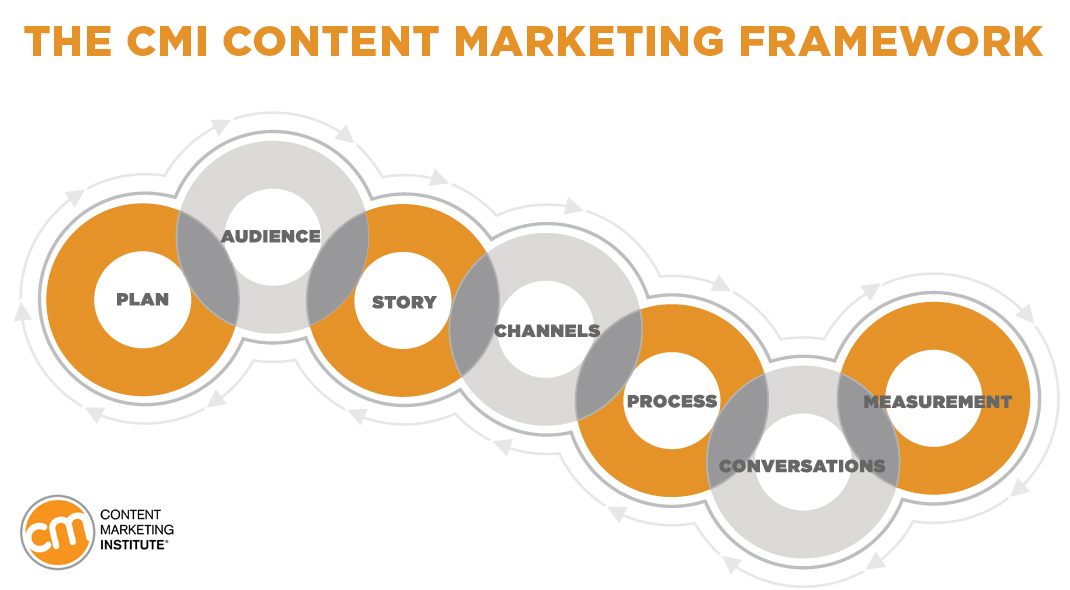
A well-defined content marketing plan provides a structured framework addressing all these issues and more. With a strategy in place, you can leverage data to continually refine and improve your efforts. Content marketing encompasses various departments, enabling sales teams to use product sheets and case studies for lead nurturing, while the marketing team utilises newsletters to attract new customers.
Regardless of your company’s size, using content to market your products or services is inevitable. Consistently doing so without a plan can lead to disjointed efforts and missed opportunities. Having a strategy ensures that everyone remains aligned, allowing you to pre-schedule content and devote more time to community engagement.
What Matters Most?
We’ve found that one of the key factors in a successful content marketing plan is aligning your content with your audience’s needs at each stage of the customer journey. Clients often discover that mapping content to specific buyer personas and stages increases engagement and relevance. Additionally, it’s critical to adopt a flexible content framework. Lastly, integrating SEO deeply into content strategy ensures that long-term visibility is baked in from the start, helping content remain discoverable over time.Get In Touch
The Importance of Content Marketing Management
The advent of content marketing management has revolutionised the landscape of content marketing. The significance of meticulous planning and analysis cannot be overstated. Techniques such as keyword research, demographic research, and A/B testing are just the beginning.
Content marketing management aids in identifying the optimal content for the most relevant platforms and channels, thereby enhancing audience engagement. This approach is pivotal in ensuring your content marketing strategy is both effective and efficient.
What key components should I include in my content marketing plan?
A content marketing plan can vary from one organisation to another but typically includes the following elements:
- Goals and KPIs: Clearly define what you aim to achieve with your content. Are you looking to increase brand awareness, educate customers, or drive sales? Document your content marketing objectives and determine specific KPIs to measure success.
- Audience: Identify who will consume your content. Creating detailed buyer personas provides a comprehensive profile of your ideal customers, allowing for more targeted content creation.
- Content Types and Channels: Determine which types of content will resonate most with your audience. While a variety of content forms can be beneficial, most brands have a predominant type, such as blogs, videos, or podcasts. Decide which channels will be most effective for distributing this content.
- Budget: Establish a budget to guide your content marketing efforts. Even if resources are limited initially, prioritise your spending to maximise impact.
- Content Calendar: Develop a schedule for your content. Brainstorm ideas, select the best titles, and organise them on a calendar. The frequency of your posts will depend on your overall strategy. Simple tools like Google Calendar, spreadsheets, or Trello can be utilised for this purpose.
- Content Creation and Distribution Plan: Content creation requires time and effort. Decide whether content will be produced in-house, outsourced to freelancers, or managed by a content creation agency. Additionally, strategise on how to distribute your content effectively through social media, newsletters, and email campaigns.
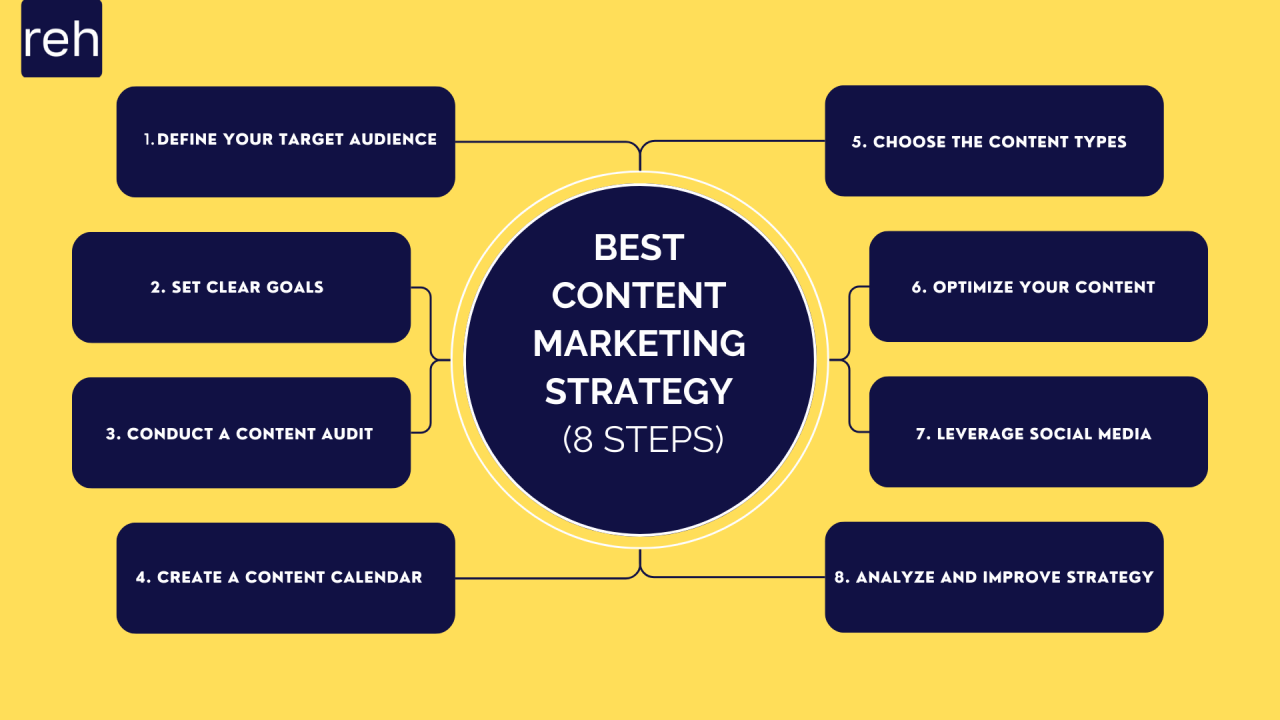
Executing Your Content Strategy
Once your plan is in place, focus on execution. Continuously monitor performance against your set KPIs and adjust your strategy as needed. By maintaining a dynamic and responsive content strategy framework, you can ensure that your content marketing efforts remain effective and aligned with your overall business goals.
Creating an end-to-end content strategy is a multifaceted process that, when done correctly, can significantly enhance your marketing outcomes. Embrace the planning phase to streamline your content marketing execution and create a solid content marketing roadmap that drives measurable success.
How do I create an effective content distribution plan?
Step 1: Determine Your Overall Content Marketing Goals and KPIs
Achieving success in content marketing requires a clear understanding of what success means for your organisation. The first step is to define your overall content marketing strategy and goals. Consider why you are creating content and what you hope to achieve with it. Common content marketing objectives include:
- Driving organic search traffic
- Building brand awareness
- Increasing audience engagement
- Generating new leads
- Nurturing leads in the middle of the sales funnel
- Fostering customer loyalty
- Boosting sales and profitability
Defining these goals will help shape your content marketing plan and ensure all efforts are aligned with your business objectives.
Source: Content Marketing Institute
Step 2: Identify the Topics That Will Attract Your Audience
To develop an effective content strategy framework, it is crucial to create content that resonates with your target audience. Start by identifying who your target customer is and what problems they are trying to solve. Key questions to consider include:
- What are your target customers’ pain points?
- How does your product or service address these problems?
- What type of information will your target customers find useful?
- Where do your customers typically seek information? Are they using search engines? If so, what are they searching for and why?
By understanding these elements, you can create a content marketing roadmap that attracts and engages your audience.

Step 3: Determine Your Distribution Plan
An effective content marketing strategy requires a well-thought-out distribution plan. Content distribution can be divided into four main categories:
- Owned Media: Channels that your company owns, such as your blog, website, and email list.
- Earned Media: Unpaid mentions by influencers or on channels like podcasts or blogs.
- Shared Media: Social media channels and online communities, including user-generated content, product reviews, shares, and retweets.
- Paid Media: Paid advertising for content promotion.
To decide which distribution channels to focus on, consider your business type and audience preferences. Often, a combination of these channels is the most effective.
Step 4: Determine Your Publishing Schedule
With your content and distribution plan in place, the next step is to establish a publishing schedule. This involves determining when and how frequently you will publish content. Using technology can significantly aid in this process. For example, Welcome’s software offers a single, easy-to-use marketing calendar to visualise all work across planned and in-flight campaigns, with real-time updates.
Key benefits include:
- Tracking the execution of all content activities and providing visibility across teams to foster collaboration.
- Monitoring campaign progress at a glance and getting a detailed view of who is working on what, and when, to ensure deadlines are met.
- Filtering the calendar to focus on the work that matters most and surfacing relevant activity for specific teams or individual contributors.
Step 5: Have a Conversion Optimisation Plan for Each Piece
In content marketing, a conversion rate represents the percentage of visitors who take a desired action, such as making a purchase. For example, if 100 people read your blog post and 10 make a purchase, your conversion rate is 10%.
To optimise conversion rates, incorporate the following strategies into your content marketing execution:
- Write compelling headlines
- Deliver on the promises made in your headlines
- Address search intent in your content
- Include case studies as evidence
- Create original graphics and charts
- Design a clean and readable layout
- Include as many relevant internal links as possible
- Feature a clear and compelling call-to-action (CTA)
By integrating these elements into your end-to-end content strategy, you can ensure that each piece of content not only engages your audience but also drives tangible results.
Source: Content Marketing Institute
5 Easy Life Hacks for Enhancing Your Content Marketing Strategy
1. Tease Your Audience with Enticing Subject Lines: Crafting compelling subject lines is a powerful way to captivate your audience, increase your email open rates, and enhance overall engagement. Effective subject lines are often short, catchy, and include numbers to pique curiosity. For instance, try lines like “Top Ten Email Marketing Tools” or “10 of the Best Webinar Techniques”. These approaches significantly boost engagement and draw readers in.
2. Create Personalised and Targeted Emails: Personalisation is key to improving email click-through rates, engagement, and customer retention. Tailoring emails to your audience can be done in various ways, such as addressing recipients by their first name, using personal pronouns like “you” and “your”, or offering loyalty programmes to reward regular customers. This personal touch makes recipients feel valued and increases the effectiveness of your email marketing strategy.
3. Include Engaging Tips and Tricks: Incorporating valuable tips and tricks in your emails showcases your industry expertise and keeps your audience engaged. This not only enhances customer engagement but also strengthens brand perception. Pose intriguing questions to stimulate interest, such as “Want to know the top ten ways to stay ahead of the competition?” or “Interested in the 10 best SEO tools?”. These elements make your content more dynamic and engaging.
4. A/B Test Your Emails: A/B testing is a critical component of any robust content marketing plan. By experimenting with different subject lines, images, headlines, CTAs, and layouts, you can identify what resonates best with your audience. Regularly test metrics such as email engagement rate, conversion rate, and click-through rate. This continuous testing allows you to refine your strategy, ensuring that each element of your email marketing is optimised for success.
5. Track Your Email KPIs and Metrics: Regularly monitoring your email marketing metrics is essential to understanding the effectiveness of your campaigns. Key performance indicators (KPIs) such as open rate, click-through rate, list growth rate, and bounce rate provide valuable insights into your campaign performance. By tracking these metrics, you can make informed adjustments to your content marketing execution, ensuring it aligns with your overall content marketing objectives and meets your target audience’s needs.
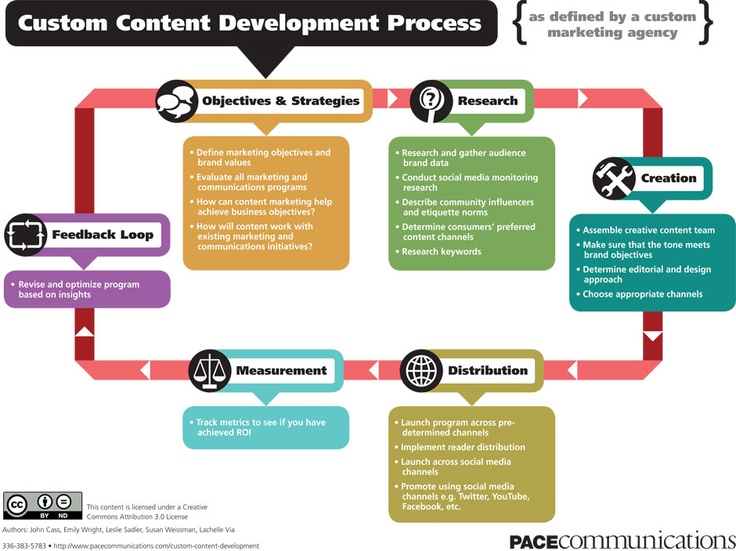
Our Tactical Recommendations
Building a content calendar with specific goals for each piece keeps the entire plan on track, helping clients see measurable outcomes. Clients often discover that creating “content clusters” with pillar content and supporting pieces can significantly improve SEO performance and content visibility. We also see that updating and repurposing older content is an often overlooked but highly effective tactic. Typically, refreshing high-performing posts not only keeps them relevant but also ensures that they continue to drive traffic and engagement over time.Get In Touch
What tools can I use to enhance my content marketing strategy?
1. Marketing Hub
Marketing Hub is an innovative content marketing tool equipped with a variety of advanced features. It includes pop-up tools, live chat, chatbots, an all-in-one WordPress plugin, and a form builder. This tool also helps you establish a scalable content marketing programme with a centralised CRM system, making it an essential part of any comprehensive content marketing strategy.
2. WordPress
WordPress offers a suite of powerful features such as website building, customised templates, website hosting, and plugin architecture. These tools enable you to create effective blogs, editorial content, and portfolios that resonate with your target audience. WordPress is a cornerstone in any content strategy framework.
3. Google Docs
Google Docs is a free, easy-to-use tool that supports your content marketing plan by facilitating content editing and collaboration. It allows you to grant editing access to other team members and enables real-time comments and suggestions, making it a vital part of your content marketing execution.
4. Grammarly
Grammarly is indispensable when developing a content marketing plan. It not only aids in proofreading but also in editing your content before publication across various platforms. This versatile tool is compatible with browsers like Safari, Firefox, and Chrome, ensuring your content remains polished and professional.
5. Yoast
Yoast is a must-have for mastering your content marketing plan, focusing on SEO to elevate your Google rankings. This tool includes features such as keyword previewing, meta-description editing, URL slugs, and internal link suggestions, forming an integral part of your content strategy blueprint.
6. Buzzsumo
Buzzsumo helps you analyse key metrics like social shares and backlinks, identifying popular topics among your target audience. This tool simplifies content curation and ensures you produce content that your audience will love, aligning with your content marketing objectives.
7. Ahrefs
Ahrefs is an excellent tool for researching competitive keywords and analysing your competitors‘ keywords and traffic. It features a site analyser, “content gap” analysis, and “top pages” insights, allowing you to leverage your competition and climb the Google rankings. Ahrefs is essential for any content marketing roadmap.



